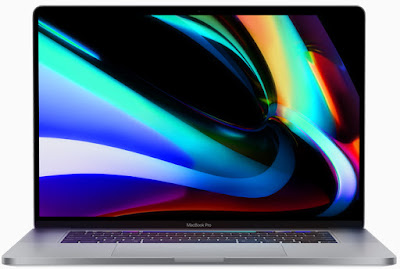I think Apple is going in the right direction with the 2019 16-inch MacBook Pro. Apple seems to be listening to their customers because of the changes from the previous 15-inch MacBook Pro. For the new 16-inch, Apple put in a Scissor-type keyboard instead of the previous Butterfly-type keyboard which has reliably problems. For most Apple Users, this is a huge improvement and I am glad Apple did this.
The 2019 16-inch MacBook Pro is a little thicker than the previous 15-inch model. Apple made it thicker to accommodate a bigger 100-Watt battery which Apple says will give up to 11 hours of Internet browsing instead of 10 hours of the previous 15-inch. To me, this could be an indication that Apple is finally understanding that it should put Function ahead of Form, because it is a computer and not a piece of artwork after all.
With the added thickness, not only has Apple been able to put in a bigger battery but has also been able to put in a better cooling system to keep the 2019 16-inch MacBook Pro’s Intel Core i9 processor with up to 8 cores and 16 threads of processing power running cooler, sustaining higher performance for longer periods of time.
The 16-inch display has thinner bezels around the edges and is rated at 500 nits of brightness. The display also has a P3 wide color gamut which enables brilliant, true-to-life images and video. The AMD Radeon Pro 5000M series video card delivers the most graphics horsepower ever in a MacBook Pro for seamless playback and faster rendering of ultra-high-definition video. With the optional 8GB of GDDR6 VRAM, you’ll get up to 80 percent faster performance when executing tasks like color grading.
In the Memory and Storage Department, the 16-inch MacBook Pro can have a maximum of 64 GigaBytes of working memory and up to 8 TeraBytes of Solid State Storage which I think is long overdue for Apple’s Pro Line of MacBooks.
Apple has improved both the speakers and added a studio-quality three-mic array. I have listened to a YouTube video comparing the YouTuber’s own studio microphone and the MacBook Pro’s studio-quality three-mic array. I could actually hear the difference. The MacBook Pro’s Mics sounded a bit muffled, probably because the mics are located under the left speaker grill but I think they sound very good anyway.
The MacBook Pro has a six-speaker sound system with Dual force-cancelling woofers dramatically reducing system vibration for a clearer, more natural sound and a half-octave lower range to the bass. The sound quality has been described as having a similar sound quality to Apple’s HomePod. I own a HomePod and it sounds great!
I do agree with other Apple professional users that for being a pro level Mac laptop, it is missing many useful ports for a pro-level mobile computer. With only 4 USB-C/Thunderbolt 3 ports, having to carry around adapters in order to connect your non-USB-C/Thunderbolt 3 devices to the 16-inch MacBook Pro, makes it inconvenient to use and not as mobile as it could be.
I think Apple needs to bring back a couple of ports that users really need including the SD card slot for transferring photos and capturing video for editing. Hopefully, prices for Solid State Storage will go down and that will lower the overall price of the MacBook Pro in the future.
Starting with the 2016 MacBook Pros, Apple left off the MagSafe power connecter because the new USB-C/Thunderbolt 3 ports are also charging ports. I want Apple to bring back the MagSafe power connector because it helps prevent pulling the Mac Laptop off the table if you snag or trip on the power cord because the power cord is connected to the MacBook by a magnet. With only the 4 USB-C/Thunderbolt 3 ports, you have to use one of them just for charging and the charging connector does not disconnect from the port easily, therefore pulling the laptop onto the floor if you snag or trip on the power cord. Be Careful.


